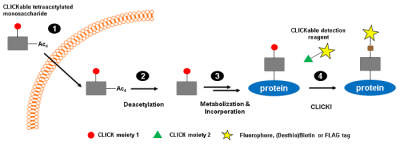Glycosylation of proteins is a posttranslational modification that is characterized by the transfer of multiple monosaccharides (glycan structure) e.g. to serine/threonine residues (O-linked glycosylation), asparagine residues (N-linked glycosylation) or tryptophan residues (C-linked glycosylation).[1] The dynamics of global glycan synthesis is an essential parameter to characterize the cellular response under various physiological and pathological conditions[2] however, metabolic labeling studies of the cellular glycan level still primarily rely on classical radioactive labeling with 3H-monosaccharides.
CLICKable tetraacetylated derivatives of naturally occurring monosaccharides N-Acetylmannosamine (ManNAc), N-Acetylglucosamine (GlcNAc), N-Acetylgalactosamine (GalNAc) provide a non-radioactive alternative for metabolic glycan labeling[2-5] (Fig. 1).
Azide-functionalized monosaccharides (Ac4ManNAz, Ac4GlcNAz, Ac4GalNAz) facilitate the subsequent detection of the correspondingly functionalized proteins via Cu(I)-catalyzed Azide-terminal Alkyne or Cu(I)-free Azide-strained Alkyne click chemistry , respectively. Cyclopropene-functionalized monosaccharides (Ac4ManNCyoc, Ac4GlcNCyoc) are detected via Cyclopropene-Tetrazine reaction[6].
Azide- and Cyclopropene-functionalizd monosaccharides are ideally suited for dual-labeling approaches.[4,5]

Figure 1: CLICKable monosaccharides are metabolically processed and subsequently incorporated instead of their natural counterparts into glycan structures of proteins (modified according to [3]).
Step 1: Intracelluar uptake of tetraacetylated CLICKable monosaccharide. Step 2: Deacetylation by endogenous esterases. Step 3: Metabolisation and incorporation into cellular glycan structures. Step 4: Detection of CLICK-functionalized proteins.
[1] Chauhan et al. (2013) In silico Platform for Prediction of N-, O- and C-Glycosites in Eukaryotic Protein Sequences. PLOS ONE 8(6):e67008.
[2] Laughlin et al. (2009) Imaging the glycome. Proc. Nat. Acad. Sci. 106 (1):12.
[3] Spaete et al. (2014) Expanding the scope of cyclopropene reporters for the detection of metabolically engineered glycoproteins by Diels-Alder reactions. Beilstein J. Org. Chem. 10:2235.
[4] Spaete et al. (2013) Rapid Labeling of Metabolically Engineered Cell-Surface Glycoconjugates with a Carbamate-Linked Cyclopropene Reporter. Bioconjugate Chem. 25:147.
[5] Patterson et al. (2014) Improved cyclopropene reporters for probing protein glycosylation. Mol. BioSyst. 10:1693.
[6] Patterson et al. (2012) Functionalized Cyclopropenes As Bioorthogonal Chemical Reporters. J. Am. Chem. Soc. 134:18638.